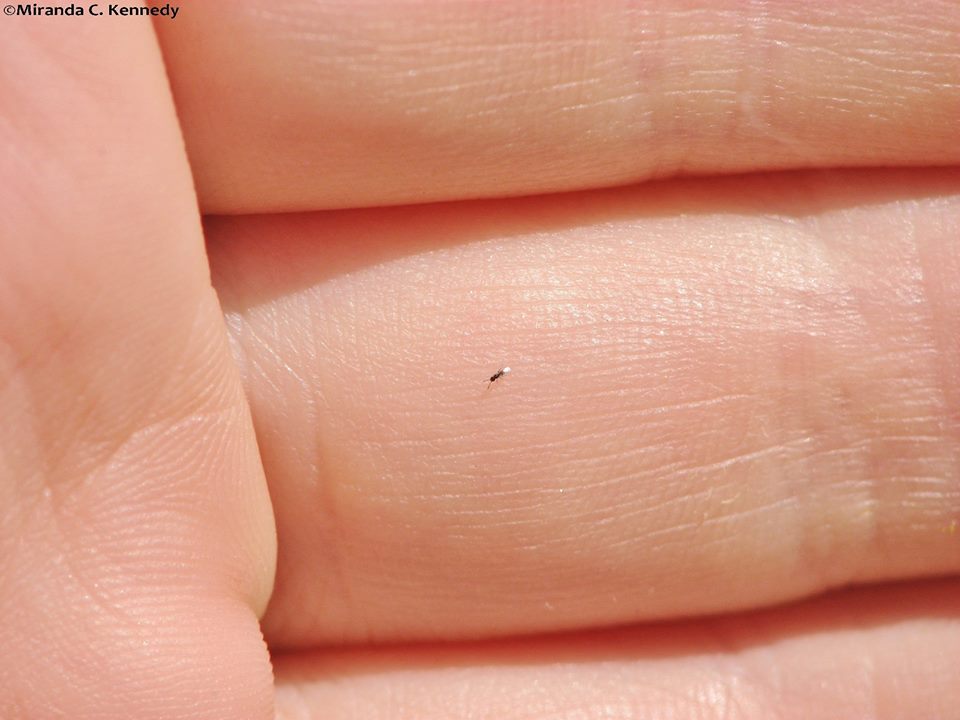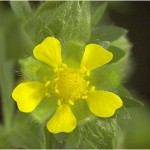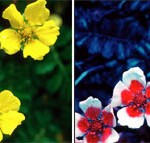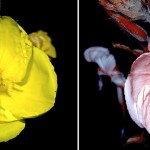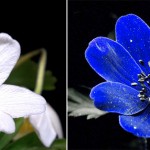Animals
-
Mrs. Two Shacks Builds a Fowl Go-Kart and a Hen Harem

And its a... go-kart? Okay, so… my chickens are currently in a deluxe San Diego summer unmovable chicken tractor. The tractor is too heavy for me to move, and the wheels (reused) have literally crumbled apart. Now it is November and the nights are becoming chilly, and we’re on the weekend rain schedule, unlike our other dry years. (Normally it rains the weekend after Thanksgiving when all the holiday events are happening, which gives the weeds time to grow so that everyone is mowing just before New Years.) My hens are cold. I know, it isn’t Minnesota; the nights are in the 40’s, but that is nippy to Southern California-bred chickens. I’ve been pondering what to do for some time now, and my Libra self has vacillated so much that now I’m up against it. Yesterday I devoted to trying to build a warm place for the chickens. I ended up with a go-kart.

I have a cage and a crate: I'll put them on wheels! I am not one to cut wood. I go out of my way to find matching pieces of wood in my huge and glorious scrap pile just so that I don’t have to measure and cut wood, because invariably I will cut it the wrong length. Fabric, too, (I have some interesting curtains). Determined to make a warm, cozy hen structure that was safe from predators (a coyote jumped the fence and killed Kakapo and took Linnet on Saturday. I was and am heartbroken and angry. I have three hens left. Oh, and Emerson.) I found a huge wooden crate that was used for a sculpture of a rodeo rider, which belonged to my parents. This thing has been taking up space for maybe twenty years in various locations. It looked the perfect size for three hens. I dragged it down the hill to the newly-straw-covered area in front of my new two sheds.

Hammering together four pieces of wood on wheels takes skill Fifteen years ago, at another house, in another life, I built a movable chicken coop that was gosh-darn good. I didn’t cut any wood for that one, either. Anyway, I still had the casters left. Pulling two long and two short pieces of 2×4 (notice I don’t give a length) out of the wood pile, I hammered them together and attached the casters, although not in that order, which made the hammering together more difficult. I purposefully didn’t use screws: I wanted to bang away with something hard on something yielding. I attached the crate after scraping out the spider webs. Now I wanted a caged area for the hens to be able to graze and get some sun. I still wasn’t completely sure where I was headed with all of this, but I was driving anyway. I dragged down an old large animal cage, which used to support a heat lamp for my African Spur Thigh tortoise until he outgrew it and tore the door off. I could fit it onto the front part of the… thing… and the casters would go through the holes in the bottom with a little help from a PVC hacksaw. (Cutting PVC is NOT the same as cutting wood, by the way, and I have oodles of experience with it. Red Hot Blue Glue nearly runs in my veins.)

The wheels fit through the wire! Wheee! I found some brackety-gizmos that made an L shape, and attached them to the bottom so that the cage hung down closer to the ground so that the hens could get at the grass.

L-shaped thingies, and the hammer head that kept flying off I attached two pieces of wood in a ‘T’ as a handle (trying to hammer it onto the frame through the cage), and then found an old dog choke collar with some lead still attached, and wrapped that around to help pull.

The pull handle, complete with choke chain. So, what if it rained? It needed a roof. There happened to be three of these triangular things left from the shed removal. I’m glad they were put to use. They had been a failed attempt to put up cat fencing (to keep them in the yard) on top of the shed roof by a friend who was a contractor. (He’s also the reason why the 8-foot wooden fence I asked for turned into a 5-foot fence up on bricks with a teal slanted cap running along the top… which makes a nice foothold for the cats.)

I knew there would be a use for these, if I waited long enough! I nailed these suckers on the crate, (ever try to nail something triangular?),

Ever try to hammer something triangular? (The successful nail is on the outside end!) then pulled out a piece of corrugated aluminum that wasn’t too sharp (and was also conveniently on top of the pile). It was too long, and not wide enough, so I grabbed some big scissor things I’ve had in the shed for years and cut the aluminum in half (they were tin snips!). Roughly. On purpose. Of course, the piece I cut didn’t fit, so I had to bend it in half, stepping on it, and drape it over the triangles then nail it on. The larger of the two I used towards the front, to give a little shade. The sun was going down and I had to hurry.
Then stuffing straw in the gap for insulation, adding a milk crate and straw inside for eggs, I stepped back to enjoy my creation.

Ummm, doesn't quite fit. Well, it wasn’t quite a chicken tractor, and it wasn’t quite a warm and cozy house. It was a go-kart.

Hay insulation I had thought to move it and the hens up into the relative safety of the tortoise and cat yard, since the cats were not allowed into the yard right now because two naughty individuals escape (so everyone else has to suffer, just like in school). With much pulling and pushing, I managed to get the kart around to the front of the hen house, and there it stayed overnight. I couldn’t get it any farther. The casters would work fine if the mulch wasn’t so thick, and if I didn’t have to pull it uphill. There was no way I was going to be able to get the kart uphill through the mulch into the tortoise yard.
Today I managed to move the kart over some grass, and one by one brought the hens over and popped them in. I got some very curious looks back from them. The chickens thought it was pretty fun, and enjoyed pulling at the tops of the grass sticking up through the cage, but after awhile they set up a chorus that couldn’t be ignored. And I still hadn’t solved the problem of their being cold at night! It was again about to be dark.

Hens wondering how to make it go Grabbing a rather stinky dog blanket, an old flowery sheet and a pillowcase (they were there, all right?) and the staple gun, I went to work. I stapled the blanket all across the back of their regular hen house loft, across the roof and let it dangle down in front of where they roost at night. Sticking my head in there (and holding my breath…. very doggie-smelling) I noticed a slight breeze still, so I stapled up the sheet and pillowcase. Emerson was quite baffled as to what I was doing next door.

How to make an expensive, well built chicken tractor look like junk in ten minutes. Then I brought the hens back, and figured it would have to do until after the holiday. A day and a half’s work and I have a heavy fowl go-kart and taudry drapings around the hen house, but I think the hens are warmer tonight. And, I must say, I think the kart is pretty cool-looking.

Gipsy hens Happy Thanksgiving!
- Chickens, Gardening adventures, Humor, Permaculture and Edible Forest Gardening Adventures, Vegan, Vegetables, Vegetarian
Planting Easter Dinner (in November)
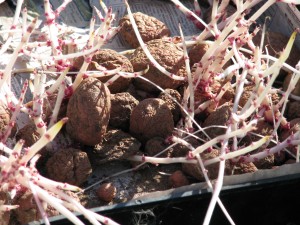
Creepy white fingers I finally was able to work in the vegetable garden today; me and my helpers, that is.
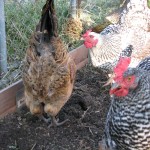
Kakapo, Miss Amelia and Lark, helping I am by no means done, but I did some major cleaning out of old veggies. Out went the tomatoes that aren’t producing, dead squash vines, weeds, a volunteer avocado tree and the two enormous zucchini plants which, although having been cut in half, abused and ignored, have still been putting on a squash a week. I have one more zuke plant left, but these big guys had to go. The compost heap is… well… a big heap.
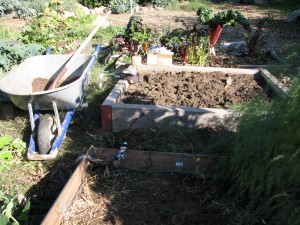
White potatoes in the closest bed, root veggies and brassica seeds in the back one As I study Permaculture, I’m more aware of the millions of microbes in the soil and the fine network of fungus that enriches plant roots. The less I disturb my garden soil, the better. After pulling the weeds, I sprinkled on GardenAlive’s soil enhancer, which are more microbes, as well as their organic Roots Alive fertilizer. I used a trowel to lightly work it all just under the soil surface, then topped it with compost from my compost bin. Having soil that is healthy, rich smelling and alive is any gardener’s dream. All those microbes free up nutrients in the soil so that your plants can suck them up and use them, which makes your veggies not only healthy and more resistant to bugs and diseases, but produce … um…. produce that is loaded with vitamins and minerals. Its like the old gardener’s joke: A gardener asks a man what he puts on his strawberries, and the man answers, “Cream.” The gardener shakes his head in disbelief and says, “I always put manure on mine.”
Potatoes from spring, which I’d stored in a dark cabinet under the house, decided they didn’t want to wait any longer.
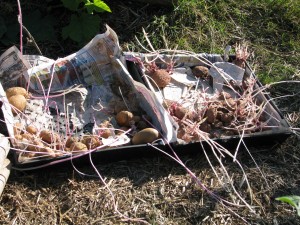
Eager potatoes Fall is a good time to plant potatoes, as long as you keep their greenery protected from frost. Since potatoes can be grown from cuttings (as well as tubers and seeds), and to produce more potatoes you slowly mound up compost or straw around the stem as it grows, I tried something with these long white fingers. I lay each potato on the soil, with the long white stem laying flat, and covered them all up with light mushroom compost.
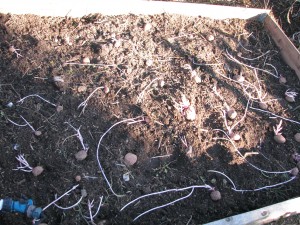
Laying down the potato stems to form new plants I’m betting that the stems will all take root and send up greenery along the nodes, using phototropism. That will multiply the number of potato plants by a lot. Then as the greenery grows, I’ll add more straw and compost around them. If all works out, sometime early next year I should be Potato Queen of Fallbrook! Of course, I had lots of help with the project.
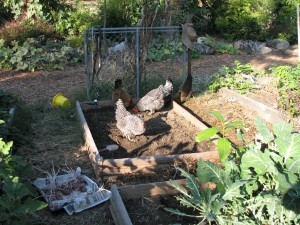
Lots of helpers. I fenced off the beds after I planted A few months ago I planted pieces of yam that had started to grow in the house. The vines flourished outside of the bed. Now that I’ve cleared the massive zucchinis out of the way, I’ve pulled the vines back into the bed, layed them out so that they (mostly) touch the soil, and have dumped mushroom compost on parts of them. The object is to allow them to root along the vines and make more yams. I’ll let you know if this works or not.

Taming the yams I’m also planting carrots and parsnips. The ‘nips won’t be ready until next spring, having improved in flavor for any frost we may receive. I’m hoping there may be some small carrots ready for Christmas dinner, but I really should have put them in last month to be sure. In will go the brassicas: Brussels sprouts (did you ever wonder if it smells cabbagy in Brussels?), broccoli and cauliflower. These guys all like a good chill, as long as they are protected from frost. More cool-weather lettuces will go in, as well as lots of endive for my tortoise. Onion sets and seeds can go in, as well as radishes. The arugula has reseeded itself again and is coming up in all the pathways, with even an elegant specimen right next to the large pond by the rushes!
You remember the pond, which was put in to attract wildlife, right?

Wildlife gathers at the watering hole.... I still have tomatoes and eggplants producing. I tied up the lazy ferny stalks of my first-year asparagus to get them out of the way. The horseradish plant seems to be doing well; I have to consider what to serve it with at Christmas. My dad loved horseradish sauce, as do I, and I grow it as a memory of him and our Polish heritage on his side. I used to make him his favorite soup, borscht, but I would never taste it because I just don’t like beets.
Tomorrow, if I can move my joints after many days of weeding, I’ll clear out the remaining ’empty’ bed and cover the unused ones with compost and straw to sit until spring. I am so glad that I can garden almost year-round!
- Bees, Chickens, Gardening adventures, Other Insects, Permaculture and Edible Forest Gardening Adventures, Vegetables
Crazy-Pot Seeds

Crazy-pot mixture of veg seeds Today, the palindromic 11/11/11, was also Veteren’s Day and a day between two rainy weekends. A perfect day for spreading lots of seeds. With winter rains on their way in a month, it is important to hold the topsoil with rooted plants, and why not use a cover crop that also fixes nitrogen? My choices were hairy vetch and a tall native lupine.
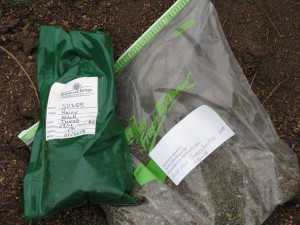
Native lupine and hairy vetch seeds I would also have liked to use white or sweet clover but sources were sold out early this year. Both my choices will have flowers that offer plenty of nectar to bees, be lovely, hold the soil, set nitrogen, and can be, if needed, sacrificed. When you ‘sacrifice’ a nitrogen-fixer, you can either turn it under or cut the tops, leaving them in place on the soil surface to decompose.
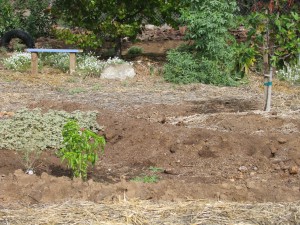
Plant guild waiting for seeds I don’t agree with disturbing my soil microbes any more than necessary, so I won’t be tilling ever again. When you cut a nitrogen-fixer, the roots release the nitrogen they hold into the soil as the tops mulch then decompose bringing lots of nutrition to the soil surface. Vetch should be a winter crop, and lupine a spring crop, if they can tell the difference here in San Diego!
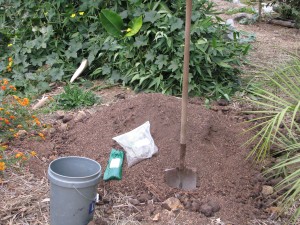
Mixing seeds with mushroom compost My method for spreading these two was to mix handfuls of each with a bucket of mushroom compost, and hand spread it in the most bare and most unfertile areas.

Broadcasting lupine and vetch seeds mixed with compost Adding the compost, I thought, helped the seed distribute more evenly, gave it a little cover since I wasn’t going to rake it in, and disguised it from birds a little.
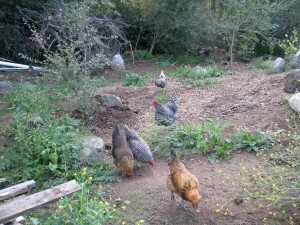
The girls. Once done, I decided it was also a good time to do something I had been looking forward to doing for years: spreading old veggie seeds. I’d done a little of this in a raised veggie bed, with some success. I have so many old packets of veggie seeds that I’m not going to use in the raised beds (I have all organic seed now), and I can’t believe that it isn’t viable. If they sprout seeds found in ancient Egyptian tombs, then I’m sure mine can sprout, too. This seeding is a very important step in the edible forest garden.
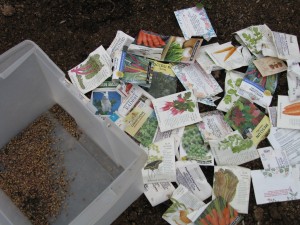
Many old winter crop seeds This year’s abundance of herbs, squash and tomatoes has been fabulous… I still have some ‘feral’ tomatoes putting on enormous fruit which I pick, polish and eat out of hand in the garden while I’m working.
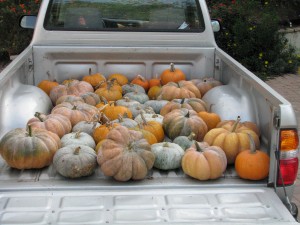
Pumpkins and squash on their way to the Fallbrook Food Pantry I opened all the packages of seed for cool-weather vegetables, such as carrots, radish, dill, broccoli rabe, and lettuces. Some such as garlic chives and onion I separated out and sprinkled near roses, since alliums are a companion plant for roses and help ward away aphids. The rest of it was mixed up in a lovely crazy-pot of seeds. I didn’t mix with compost this time, as there were fewer and smaller seeds involved. I sprinkled them then covered them with soil using my foot… the professional way to plant!

Scattering veggie seeds I am eager to see what comes up after the rain this weekend. It truely will be an edible landscape. Even if I allow the veggies to go to seed, the blooms will all be excellent bee food sources, especially the carrots and dill. None of these were nitrogen-fixers, because I used all the extra peas up in the vegetable beds this spring (see archives) improving the soil. Beans, and other warmer-weather seeds I’m holding back for February or March planting. I do have sweetpea seeds to plant out, but the lupine and vetch will be working their magic anyway.

Embankment with ragweed, now seeded with lupine and vetch 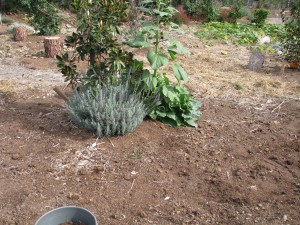
Under the soil is now daffodil bulbs, lupines, vetch and mixed vegetable seeds About ten years ago I had a short story published in the young person’s magazine Cricket called Taking Tea with Aunt Kate. In it a girl lived with her mother who was a wild, messy gardener, spreading seeds all together and having veggies and flowers mingling in riots of color. The girl’s aunt is, by contrast, perfectly coiffed and takes her to a formal ‘high tea’ at a prestigious restaurant. The girl decides that she can be a little of each woman, a little wild and a little formal. I think I’m that child! I clean the dirt out from under my nails so that I can go to the opera.
I’ll be walking the garden in the next few weeks, waiting for tell-tale sprouts (and trying to figure out if they are weeds or not!), and watching the bare areas come to life. How fun!
- Bees, Gardening adventures, Other Insects, Permaculture and Edible Forest Gardening Adventures, Vegetables
Nitrogen-Fixing Plants
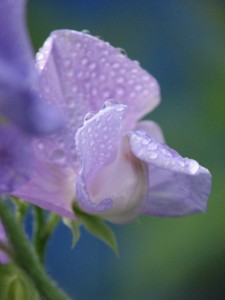
Sweet pea If you’ve read my posts from this spring, you’ll have endured me going on and on about peas and beans and how they fix nitrogen in the soil. For those who nodded off during those episodes or who have just tuned in, I’ll go over it briefly.
Some plants have the ability to fix nitrogen in the soil. Actually, a type of bacteria called a rhizobia invades the roots of plants in the Fabacea family and a few others, and fixes atmospheric nitrogen in nodules on the plant’s roots. This is beneficial to both the plant and the bacteria, a process called mutulism. It also benefits whatever grows around the plants because, when the plant dies, the nodules release their nitrogen into the surrounding soil. In the case of long-lived shrubs and trees that fix nitrogen, as roots die off or are replaced, they release their nitrogen.
An edible forest garden is one where man mimicks the dynamics of an old-growth forest. Why? Because forests succeed without the aid of fertilizer, tilling, mulching, irrigation or any interference or ‘help’, as it were, from man. How does it do this? The plants that grow complement each other, providing what each other needs. These relationships are called plant guilds. You can create plant guilds, substituting plants that provide food for humans. In a guild there is a taller tree which provides shade and leaf droppings (mulch), shrubs which provide more shade, mulch and habitat for animals and insects, plants that fix nitrogen in the soil, plants that have long tap roots called ‘miner’ plants, because they take up nutrients from deep in the soil and deposit them on the soil surface when their leaves die off, plants that attract pollinators, and plants that are ground covers to regulate heat and moisture. Using permaculture practices for water harvesting and organic gardening, when the guild matures it should be almost completely self-sustaining.
Say you want to plant an apple tree. That would be your tall canopy tree for the guild, which drops leaves as mulch. Beneath it, you could plant a shrubby herb such as rosemary (another edible), daikon radishes (miners, leaving the cut leaves on the surface after harvesting the edible root), bush beans (legumes) and herbs such as dill, parsley and basil, some of which you allow to flower for pollinators. As the tree grows, the plant guild can widen and others planted.
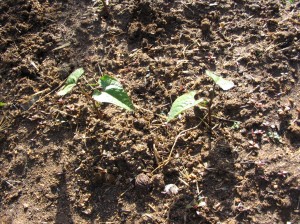
Beans There are many plants, trees and shrubs that fix nitrogen in the soil. All beans and peas including soybeans and fava beans do; when the plants are finished cut them above the soil so the roots stay put and decay where they are to release the nitrogen. Cover crops such as clover and hairy vetch are grown and turned under to improve the nitrogen in the soil. If you are from the Southern California area, perhaps you’d be interested in knowing what native plants are nitrogen fixers.

Ceanothus (California Lilac) at Elfin Forest The native Southern California nitrogen fixers include: ceanothus, lupine, deerweed, California peashrub (endangered) (lotus), and redbud. Non-natives that are commonly used are alders, acacias, calliandra, sweet peas, guaja, and many more, as the Fabacea family is very large. Use any of the natives in ornamental gardens and not only will you be improving the soil and the vigor of the surrounding plants, but providing much needed habitat for our native birds and insects.
Try building plant guilds; it is challenging and fun. Many combinations of plants are suggested on permaculture
-
Stuck Rat

I wasn't sure what I was seeing from the kitchen. Tree rats are part of life in a rural area. They have cost me hundreds of dollars in damage to my cars, since they love eating the tubing and enjoy the warmth inside for nesting. However they have their place… just not in my stuff. So when I looked out the window this morning while eating breakfast and saw a very un-birdlike creature in the hanging bird feeder, I had to go outside and see if it really was what I thought it was. Already the temperature was over 90 degrees in this heat wave, and it was only about 8 am.

Wood rats are one of three types found in San Diego County Rats don’t like the sun, being nocturnal, and the way this youngster was just hanging over the edge made me think he was ill. Then I thought that he looked as if he was stuck. I took a shovel and put the end up under his head, and he stirred, then gracefully stepped down on it and jumped off into the columbine. I think he was just a kid who had a bad case of the Where Am I?’s. I told him not to go into my cars. He did pose in a very picture-book fashion, becoming the most adorable rat I’ve ever seen.
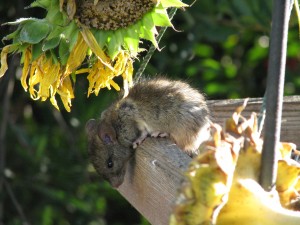
A long way down for a young animal. - Bees, Birding, Gardening adventures, Heirloom Plants, Other Insects, Permaculture and Edible Forest Gardening Adventures, Photos
Bouquets for Birds and Butterflies

Lilliput zinnia At the beginning of this summer, the new subterranean drip irrigation system was installed on my property. It features tubing with holes at either twelve or twenty-four inches apart. When it runs (from my well) it leaves circles of dampness polka-dotting the soil surface. I had purchased two packets of wildflower seed, one with a selection of plants to attract bees, and the other for butterflies. Mixing them together, I figured that they wouldn’t fare well scattered, at least this year. My daughter and I pressed seed into many of the wet spots and hoped the rabbits wouldn’t notice.
What happened was a delightful surprise, as only a garden can provide. In many locations around the yard grew mixed bouquets of wildflowers.

Mexican sunflower, cosmos, nasturtiums, zinnias, surround a white calla lily If we had separated selected seed and planned the planting, nothing so beautiful would have come of it. Although many species either didn’t emerge or were eaten, the most common survivors were zinnias, cosmos and borage.

Cosmos, borage, zinnias and alyssum. I was amazed and thrilled; I had purchased a borage plant and then fed it to the rabbits (at least, that is what they thought). Here now are borage plants all over the yard, their royal blue, cucumber-flavored flowers dipping modestly behind the flaunting cosmos.
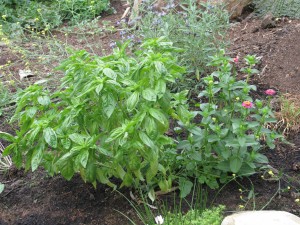
Sweet basil, cilantro, dill and zinnias In fact, I now have several very hearty sweet basil plants that put the carefully cultivated plants in my raised veggie beds to shame. There is also dill and cilantro growing well even this late in the season.

Cosmos, sweet basil, zinnias, borage, camellia balsam, alyssum There are some plants in the bouquets that haven’t reached maturity yet, so there may still be some surprises. The only flower that emerged that I didn’t recognize and had to look up was camellia balsam (Impatiens balsamina). Two stalks of it, one pink and one red, give these ‘arrangements’ a vertical line.
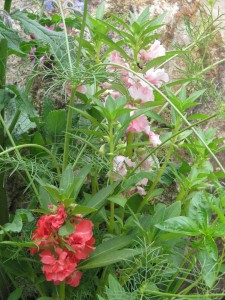
Camellia balsam (Impatiens balsamina) Although not all of these wildflowers are native to San Diego, or even California, they provide food for birds, bees and are host plants for butterflies, providing the caterpillars food, a place to form their chrysalises, and nectar for the mature butterfly. Bees like small flowers with little drops of nectar too small to drown in, with a nice landing pad of a petal close by. Everything in the carrot family works well. Here are some suggested flowers to plant:
For butterflies:
Mexican lupine, Mexican sunflower, borage, calendula, camellia balsam, scabiosa, cornflower, milkweed, parsley, crimson clover, aster, coreopsis, cosmos, prairie gayfeather, purple coneflower, sweet sultan, sneezeweed, sweet William, bishops flower, black-eyed Susan, dill, snapdragon, yarrow, bergamot, cleome, verbena, and butterfly bush.
For bees:
Cosmos, sunflowers, borage, coriander, Siberian wallflower, dill, coreopsis, poppies, gaillardia, zinnia, sweet basil, purple prairie clover, globe gillia, catnip, lemon mint, black-eyed Susan, goldenrod, lavender hyssop, bergamot, yarrow, mint, California buckwheat.
Be sure to plant flowers that bees love away from paths and walkways if you or your family want to avoid contact with the bees.
- Animals, Bees, Gardening adventures, Heirloom Plants, Other Insects, Permaculture and Edible Forest Gardening Adventures, Vegetables
What Bugs See
To veer off from the vacation photos, I thought I’d talk about bugs! I’ve been working in the garden a lot and watching the myriad types of insects drawn to the various flowers blooming all over, and it reminded me of something amazing that I learned last year. The way flowers look to us is not what most insects and birds see. The flowers are bright and showy, but they offer up visual clues to pollinators through colors and patterns that can only be seen with eyes that see UV light. Humans can’t. We can’t assign colors to UV light in the way that we understand them, so when photographing with UV light we substitute our colors to show the change in patterns. The markings on the flowers are guides to where the pollen is, like lights and painted lines on airport runways. Just as baby chicks’ mouths are large and brightly colored to show mom and dad where to put the worm, especially on the inside as they gape and wait to be fed, so have flowers made sure that the pollinators get to the right place for pollen! The differences between what we see and what insects see can be startling; there is a whole hidden world right before our eyes, just as there are supersonic and subsonic sounds that we cannot hear. Elephants make subsonic noises that other elephants can hear miles away, but we aren’t aware of it.
Below are photos taken with and without UV light by the brilliant Norwegian scientist-cameraman Bjorn Roslett. Remember that the UV colorization is man-made to show the difference in patterns. More technical information can be found at his site here: http://www.naturfotograf.com/UV_flowers_list.html , with lists of types of flowers and what approximate color changes there are under UV light.
Dandelion Vinca minor Vinca minor under UV Norsk mure (Potentilla norvegica) Norsk mure under UV Primrose Crocus Anemone -
Bathing a Hen
Between harvesting, drying, weeding, watering and keeping out of the sun, we’ve been very busy with the garden and animals, so I apologize for not writing often. If you’ll remember one of our hens, Evelyn, passed away due to egg binding. Egg binding is just what it sounds like: they don’t come out, and it can be fatal. Another of our chickens, Kakapo, showed signs of trouble and we gave her baths and babied her, and now she is laying enormous eggs (poor girl!). Now Lark, the darker of the two Barred Rocks, is having trouble. She laid one egg and perhaps a weak-shelled one as well, and then nothing. We had her in a cage in the living room, gave her warm baths then put her out. Still nothing. Then yesterday she was acting very strangely during the day, so we gave her another warm bath and a massage.

Lark Spa There isn’t much else to do. Of course, we’re leaving for ten days starting tomorrow, and although there will be a housesitter living here, I don’t think chicken bathing is on her to-do list. Things always happen just before going on vacation, of course, so one of our cats isn’t looking good but refused to be caught, and our desert tortoise Homer is still missing. We have signs up (if people would stop taking them down!) and hopefully he’ll make himself known to people.
I’ll be without Internet on our trip. We will be birding and looking at historical and natural wonders in Cornwall, England, including Land’s End, Penzance, Jamaica Inn, Camelot, and the Isle of Scilly. I wanted to blog on the trip but we are keeping our luggage to carry-ons, and the choice between hiking boots and a laptop was a clear one to me. So I’ll post about our travels after the 16th. Send happy thoughts to our animals and housesitter! Take care. -
Of Monarchs and Milkweeds

Monarch (photo: Miranda Kennedy) The migration of the monarch butterfly covers an astounding 2500 miles. Instead of dying off in the cold of winter, these flimsy, light-as-air insects fly from parts of the US to groves of Oyamel fir trees in Mexico. They are the only insect to cover such territory. They are particular little beasties, for they rest only in the Oyamel firs and look for milkweed plants on which to lay their eggs. Milkweed exudes a sap toxic to animals which the Monarch caterpillars eat, obviously immune, making them toxic in turn. The caterpiller’s bright coloration is a warning.

Snazzy stripes mean 'eat at your own risk' (photo: M. Kennedy In fact, the Viceroy butterfly, which is very tasty to predators, mimics the Monarch’s coloration to keep from being dinner.
Deforestation, insects, climate change and pollution have cut a huge swath through the Oyamel fir tree population, and the Monarchs are struggling to survive. They also combat the decrease in milkweed as human populations spread and plant lawns instead of weeds and wildflowers.
At the beginning of this year, in my efforts to change my property into habitat, I was determined to help the Monarchs. Every year I see maybe one or two of the majestic butterfly pass through my yard, and I’ve been sorry that I can’t offer he or she anything except nectar.
What I had been calling milkweed actually is sow thistle Sonchus oleraceus, which is an edible kitchen herb brought over from Europe with the settlers as food. It also has a milky sap in it’s hollow stem, thus the erroneous name of milkweed. There are over 100 varieties of real milkweed. So, I purchased two Balloon Plants, or Asclepias physocarpa (Asclepias is the botanical name for the milkweed family). They grew quite well, developing the balloon-shaped seed pods which, when ripe, burst open spreading small seeds with feathery wings attached that carry them everywhere.

Seeds burst and fly To my great excitement my daughter spotted very tiny Monarch caterpillars on the leaves!

Tiny Monarch caterpillers (photo: M. Kennedy) The caterpillars have been eating voraciously and growing big and fat.

Monarch caterpiller and milkweed (Photo: M. Kennedy) We’ve seen Monarchs in the yard many more times than in the past. We are monitoring the caterpillars closely, waiting for them to metamorphosize. I’ll help the plants distribute seeds throughout my yard, and I’ll plant the native narrow-leafed milkweed as well. I’m so excited that within months this goal was achieved and that these wonderful creatures have one more place to find refuge.
Good links:Monarch Watch http://shop.monarchwatch.org/ , Monarch Migration http://www.monarchbutterflyusa.com/Migration.htm.
-
Finches Eat Sunflower Leaves
Are your sunflowers being stripped? Are the leaves acquiring non-snail-like holes and then disappearing altogether? You may be feeding the birds, but not with the seeds!
Lesser goldfinches apparently are nuts over sunflower leaves. They will tear little bits of the leaves off and injest them, and within a day or so there will be nothing but a stem and a flower.

If your goal is to feed the birds, then this is okay. If you have bird problems on your vegetables such as peppers, then you may want to plant sunflowers off to the side to distract them.

Why do they eat sunflower leaves? They must like a little salad with their seeds, and sunflowers are particularly yummy for them. In searching the Internet for suggestions as to why they like sunflower leaves so much, there were many postings about the incidents, and yet most respondents insisted that the birds were after bugs on the leaves, or that snails came in the night and ate the leaves!
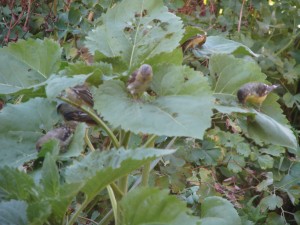
This occurrence seems to happen mostly in California, and other than bird nets (which one person said that the lesser goldfinches chewed through!) or planting sunflowers thickly (one for them, one for you), you may as well just enjoy the show. Ours come up from dropped or buried birdseed, and when the plants are growing their flowers, suddenly they are beset by birds who skeletonize the plant. We’re okay with that; it saves a little cost on the very expensive Niger thistle seed! (Oh, and by the way, Niger thistle isn’t thistle seed at all).
